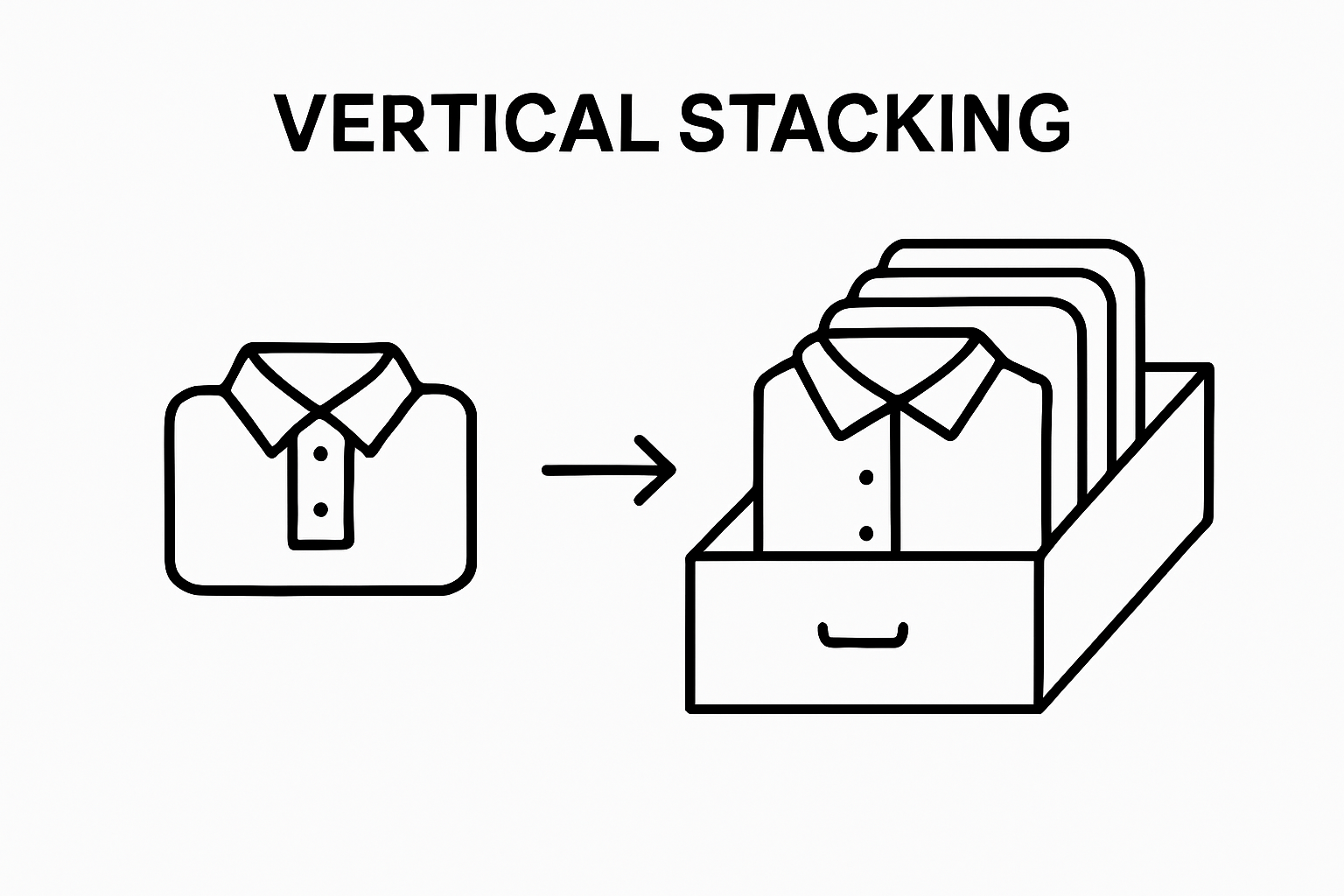
Getting your closet in order always sounds straightforward and satisfying. No wonder so many people try to crack the code for tidier living, especially when you realize that systematic organization can maximize storage efficiency by up to 30 percent according to major university research. Yet most overlook one simple truth. The real secret to a perfect wardrobe has very little to do with buying storage boxes or folding fancy origami. It all starts with preparation and what you do before the first shirt touches the table.
Table of Contents
- Step 1: Gather Your Folding Supplies And Space
- Step 2: Categorize Your Items For Folding
- Step 3: Utilize The Best Folding Techniques For Each Item
- Step 4: Evaluate Your Folded Items For Consistency
- Step 5: Organize Your Storage Space With Folded Items
Quick Summary
| Key Point | Explanation |
|---|---|
| 1. Clear workspace is essential | A clean, organized area with good lighting sets the stage for effective clothing folding. |
| 2. Categorize items by fabric type | Sorting clothing by fabric weight and type simplifies the folding process and ensures appropriate handling. |
| 3. Use specific folding techniques | Different fabrics require tailored folding methods to minimize wrinkles and maintain their shape. |
| 4. Maintain consistency in folding | Use a standard template to ensure each item is folded uniformly, enhancing organization and appearance. |
| 5. Organize for easy access | Prioritize item accessibility based on usage frequency and arrange folded garments vertically to save space. |
Step 1: Gather Your Folding Supplies and Space
Mastering the best folding techniques starts with creating an efficient preparation environment. Before diving into the actual folding process, you need a clean, organized workspace that supports your organizational goals. The right setup can transform a tedious task into a smooth, almost meditative experience.
Start by selecting a flat, clean surface like a dining table, bed, or large countertop. The surface should be spacious enough to spread out clothing items completely and provide room for maneuvering. Clear the area of any existing items, ensuring you have a pristine workspace dedicated to your folding project. Good lighting is crucial - natural daylight or bright overhead lights help you see fabric details and prevent misalignments.
Your folding toolkit should include a few key items to streamline the process:
- A sturdy folding board or template (optional but recommended)
- Clean, flat surface
- Sharp scissors
- Measuring tape
- Stack of hangers or storage containers
- Fabric-friendly spray starch (for crisp edges)
Consider organizing your storage solutions before beginning. According to research from the University of Massachusetts Amherst, systematic organization maximizes storage efficiency and ensures immediate access to all items.
Before starting, sort your items by fabric type, weight, and intended storage method. Delicate fabrics like silk require gentler handling compared to sturdy cotton items. Separate items into categories such as workout wear, professional attire, casual clothing, and linens. This pre-sorting step will make your folding process more structured and less overwhelming.
Verify your workspace is ready by doing a quick checklist: clean surface, good lighting, all necessary tools within reach, and items pre-sorted. Your preparation sets the stage for perfect, consistently folded clothing that saves space and looks incredibly neat.
Here is a summary table of essential tools and supplies for setting up an efficient folding workspace, along with their purposes and any notes on optional use:
| Tool/Supply | Purpose | Notes |
|---|---|---|
| Folding board/template | Ensures uniform, consistent folds | Optional but recommended |
| Clean, flat surface | Provides space for laying out and folding garments | Choose table, bed, or counter |
| Sharp scissors | Removes tags or stray threads | Keep nearby if needed |
| Measuring tape | Checks fold or stack consistency | Useful for standardizing |
| Stack of hangers/containers | For items unsuitable for folding or for storage | Use as needed |
| Fabric-friendly spray starch | Maintains crisp fold edges and prevents wrinkles | Recommended for dress shirts |
Step 2: Categorize Your Items for Folding
Categorizing your items is a critical foundation for achieving the best folding techniques and creating an organized storage system. This step transforms a potentially chaotic pile of clothing into a systematically arranged collection that makes future retrieval and maintenance significantly easier.
Fabric weight and type are your primary categorization factors. Different materials require unique handling and folding approaches. Start by separating your items into primary categories: lightweight fabrics like silk and thin cotton, medium-weight materials such as standard cotton t-shirts and dress shirts, and heavyweight fabrics including denim, winter sweaters, and thick jackets.
Within each fabric category, create subcategories based on usage and storage requirements. Professional attire might include dress shirts, slacks, and blazers. Casual wear could encompass t-shirts, jeans, and loungewear. Athletic clothing represents another distinct category with specialized moisture-wicking materials that often benefit from specific folding methods.
Color coordination offers an additional organizational strategy. Arranging items from light to dark or grouping similar color tones can make visual identification easier and create a more aesthetically pleasing storage system. Pro tip: white and light-colored items should be separated to prevent color transfer during storage.
Consider seasonal variations in your categorization approach. Winter clothing requires different storage techniques compared to summer wear. Learn more about efficient storage solutions that can help manage seasonal clothing transitions.
According to research from the University of Illinois Library, systematic categorization significantly improves organization efficiency. Your sorting strategy should consider these key factors:
- Frequency of use
- Fabric sensitivity
- Storage destination (drawer, shelf, hanging)
- Potential wrinkle susceptibility
Before moving to the next folding step, verify your categorization by conducting a quick visual check. Ensure each pile represents a distinct, logical grouping. Items should be cleanly separated, with no misplaced clothing interrupting your carefully planned categories. A well-categorized collection sets the stage for precision folding and optimal storage efficiency.
Step 3: Utilize the Best Folding Techniques for Each Item
Understanding the unique folding requirements for different clothing types is essential in mastering the best folding techniques. Each fabric and garment demands a specific approach to ensure minimal wrinkles, optimal space conservation, and long-term preservation of the item’s structural integrity.
Lightweight fabrics like t-shirts and cotton tops require a precise, compact folding method. Begin by laying the item flat, smoothing out any wrinkles with your hands. Fold the sides inward to create a narrow rectangle, then fold the bottom third upward, followed by the top third downward. This creates a neat, uniform package that stacks beautifully in drawers and minimizes creasing. For dress shirts, a more structured approach is necessary. Start by buttoning the shirt completely, then lay it face down. Fold the sleeves inward at a 45-degree angle, creating a straight line from the shoulder. Fold the sides toward the center, creating a compact rectangle that maintains the shirt’s crisp appearance.
Heavier items like sweaters and knits demand a gentler touch. Avoid hanging these items, as they can stretch and lose their shape. Instead, fold them loosely to prevent unnecessary stress on the fabric. Place the sweater face down, fold the arms inward, and then fold the bottom third upward. This method prevents stretching and maintains the garment’s original structure. Learn more about preserving your clothing during storage to extend the life of your favorite pieces.
According to research from the Smithsonian Institution, proper folding techniques are crucial for fabric preservation. Your folding strategy should consider these critical elements:
- Minimizing sharp creases
- Preventing unnecessary fabric stress
- Maintaining the original garment shape
- Creating uniform, stackable packages
Special consideration is needed for delicate items like silk blouses, lingerie, and dress pants. For silk, use a soft tissue paper between folds to prevent permanent creasing. Dress pants should be folded along their natural crease line, with the legs aligned precisely to maintain a professional appearance. Athletic wear made from moisture-wicking materials benefits from a looser fold that prevents compression of the fabric’s technical properties.
To verify your folding technique, check each item for these signs of successful folding: uniform thickness, minimal visible creases, and the ability to stack neatly without bulging or shifting.
A well-folded collection not only saves space but also makes selecting and maintaining your wardrobe significantly easier.
This table compares folding techniques for the main clothing categories described, specifying recommended methods, special considerations, and intended results:
| Item Type | Recommended Folding Method | Special Considerations | Desired Result |
|---|---|---|---|
| T-shirts/Cotton Tops | Fold sides in, create rectangle, fold in thirds | Smooth wrinkles before folding | Compact, consistent, minimal creases |
| Dress Shirts | Button up, lay face down, fold sleeves at 45°, rectangle | Align sleeves, maintain structure | Crisp, professional, stackable |
| Sweaters/Knits | Face down, arms in, fold bottom third up | Avoid hanging, loose to prevent stretch | Maintains shape, reduces fabric stress |
| Silk/Delicate Items | Fold gently, use tissue paper between folds | Prevent permanent creasing | Safe, wrinkle-free storage |
| Dress Pants | Fold along natural crease, align legs | Keep creases sharp | Professional appearance |
| Athletic Wear | Looser fold, don’t compress technical fabric | Avoid compressing moisture-wicking areas | Preserves fabric properties, stackable |
Step 4: Evaluate Your Folded Items for Consistency
Consistency is the hallmark of professional-level organization, transforming a random pile of clothing into a meticulously arranged collection. Evaluating your folded items requires a systematic approach that goes beyond mere visual inspection, focusing on precise measurements, uniform dimensions, and strategic alignment.
Begin by establishing a standardized folding template that serves as your primary reference point. This could be a rigid folding board or a custom-made cardboard guide that ensures each item follows the exact same folding parameters. Place each folded item against this template, checking that the width, length, and thickness match your predetermined specifications. Pay special attention to the edges and corners, ensuring they align perfectly and create sharp, clean lines.
Measurement becomes your most critical tool in this evaluation process. Use a measuring tape to verify that each folded item maintains consistent dimensions within its specific category. Lightweight t-shirts should have uniform rectangles, while dress shirts require precise shoulder-to-shoulder and length measurements. Variations of more than half an inch can disrupt your entire storage system, creating uneven stacks and potential space inefficiencies.
Visual uniformity extends beyond mere measurements. Examine the folded items for symmetry, checking that patterns, seams, and design elements align consistently. Solid-colored items should display crisp, parallel folds, while patterned clothing requires additional attention to ensure design continuity. Explore advanced storage optimization techniques to complement your precise folding method.
According to research from PubMed on folding skills, consistency in folding requires careful planning and manual control. Your evaluation should focus on these key consistency markers:
- Identical fold width across all similar items
- Uniform thickness of folded packages
- Precise alignment of edges and corners
- Consistent orientation of patterns and seams
Implement a rotation strategy during your evaluation. Turn each folded item to inspect it from multiple angles, ensuring the fold maintains its integrity from every perspective. This comprehensive approach helps identify subtle irregularities that might compromise your organizational system.
To verify successful evaluation, stack your folded items and observe their collective appearance. A truly consistent collection will create a visually harmonious, almost architectural display. Each item should sit perfectly flush with its neighbors, creating a seamless, intentional arrangement that speaks to your meticulous attention to detail.
Use this checklist table to verify the key consistency criteria when evaluating your folded items for a professional-looking, neat clothing arrangement:
| Consistency Checkpoint | Description | How to Verify |
|---|---|---|
| Standardized fold width | All items in category have matching width | Use folding template, measure dimensions |
| Uniform package thickness | Stacks are even, with no bulging or gaps | Compare side heights in stacks |
| Edge & corner alignment | Edges and corners are sharp and aligned | Stack for visual uniformity |
| Pattern/seam consistency | Patterns, seams, or graphics line up | Visually inspect stacked items |
| Minimal visible creases | Folded surfaces look smooth and neat | Look for wrinkle lines |
Step 5: Organize Your Storage Space with Folded Items
Transforming your meticulously folded clothing into a strategically organized storage system requires more than simply stacking items. The goal is to create an intuitive, accessible arrangement that maximizes space while preserving the integrity of your carefully folded garments.
Vertical stacking emerges as the most efficient storage method, particularly for drawers and shelving units. Instead of traditional horizontal stacking, arrange your folded items vertically, creating a file-like system where each item stands upright.
 This technique allows you to see every piece at a glance, eliminating the need to dig through layers and potentially disrupting your perfectly folded arrangements. Lightweight fabrics like t-shirts and thin sweaters work exceptionally well with this method, allowing you to maximize drawer space and visibility.
This technique allows you to see every piece at a glance, eliminating the need to dig through layers and potentially disrupting your perfectly folded arrangements. Lightweight fabrics like t-shirts and thin sweaters work exceptionally well with this method, allowing you to maximize drawer space and visibility.
Prioritize your storage zones based on frequency of use. Place everyday items in easily accessible drawers or shelves at eye level, while seasonal or less frequently worn clothing can be stored in higher or more remote locations. Color coordination can elevate your organizational strategy, creating a visually appealing and intuitive system. Arrange items from light to dark or group similar color tones together, making selection and maintenance significantly easier. Check out professional bedroom storage strategies to further refine your approach.
According to research on space management, systematic compartmentalization significantly improves storage efficiency. Your organizational strategy should consider these essential elements:
- Frequency of item usage
- Fabric weight and sensitivity
- Color and style coordination
- Accessibility and visibility
Utilize storage dividers and containers to create distinct zones within your drawers and shelves. Fabric-friendly dividers prevent items from shifting and maintain the crisp folds you’ve carefully created. Clear plastic containers with lids can protect seasonal items from dust while allowing you to see the contents without opening them. For delicate items like silk blouses or fine knitwear, consider adding acid-free tissue paper between layers to prevent potential fabric damage during extended storage.
To verify your storage system’s effectiveness, perform a quick accessibility test. Can you retrieve any item without disturbing the surrounding garments? Do your folded items remain crisp and wrinkle-free? A well-organized storage space should feel intuitive, with each item easily visible and accessible, reflecting the care and precision you’ve invested in your folding technique.

Transform Your Folding Success Into Lasting Home Organization
Tired of seeing meticulously folded clothes unravel into messy piles in overcrowded drawers or closets? You know how much effort goes into choosing the best folding techniques and creating a consistent, neat stack. Still, without the right storage solutions, all that hard work quickly disappears. Frustration sets in when you struggle to maintain your organized system, and bulky or delicate fabrics get squashed, hidden, or wrinkled again. The article emphasized the importance of vertical stacking, compartmentalization, and preserving crisp folds—yet everyday living often gets in the way.

It’s time to turn your handiwork into true home harmony. Discover quality storage solutions that work seamlessly with your favorite folding methods. Find sleek storage boxes, smart containers, and sturdy dividers designed to keep every item in place. Choose style and function so your space looks fantastic and feels easy to manage. Don’t let today’s tidy effort go to waste. Visit BlushBees Home Organization now and see how the right tools protect your perfectly folded wardrobe. Shop today and enjoy a neater, more beautiful home—your freshly folded items deserve it.
Frequently Asked Questions
What is the best way to prepare my space for folding clothes?
To prepare your space effectively, choose a clean, flat surface like a dining table or bed, ensure good lighting, and gather necessary tools such as a folding board, measuring tape, and storage containers. Pre-sort your items by fabric type and intended storage method to create a structured folding process.
How should I categorize my clothing before folding?
Categorize your clothing based on fabric weight and type, such as lightweight, medium-weight, and heavyweight items. Further categorize by usage, such as casual wear, professional attire, and athletic clothing. Additionally, consider color coordination for easy visual identification.
What are some effective folding techniques for different types of clothing?
Lightweight fabrics like t-shirts should be folded into compact rectangles, while heavier items like sweaters should be folded loosely to prevent stretching. Delicate fabrics like silk benefit from tissue paper between folds, while dress shirts should be folded to maintain their crisp structure.
How can I ensure consistency in my folded items?
To ensure consistency, use a standardized folding template and measuring tape to check the dimensions of each folded item. Look for uniform thickness, alignment of edges and corners, and visual symmetry to maintain a neat appearance. Regularly rotate and inspect items from different angles for any irregularities.
Recommended
- Maximize Space and Declutter with Collapsible Storage Boxes: The Ultim – BLUSHBEES USA
- 10 Home Organization Tips for a More Tidy and Efficient Living Space – BLUSHBEES USA
- How to Store Linens: Easy Tips for an Organized Home (2025) – BLUSHBEES USA
- Top Under Bed Storage Hacks for Stylish Homes in 2025 – BLUSHBEES USA



